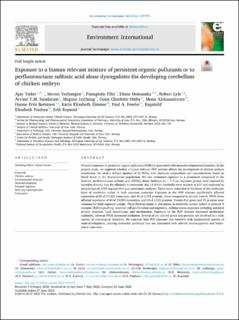Exposure to a human relevant mixture of persistent organic pollutants or to perfluorooctane sulfonic acid alone dysregulates the developing cerebellum of chicken embryo
| dc.contributor.author | Yadav, Ajay | |
| dc.contributor.author | Verhaegen, Steven | |
| dc.contributor.author | Filis, Panagiotis | |
| dc.contributor.author | Domanska, Diana | |
| dc.contributor.author | Lyle, Robert | |
| dc.contributor.author | Sundaram, Arvind | |
| dc.contributor.author | Leithaug, Magnus | |
| dc.contributor.author | Østby, Gunn Charlotte | |
| dc.contributor.author | Aleksandersen, Mona | |
| dc.contributor.author | Berntsen, Hanne Friis | |
| dc.contributor.author | Zimmer, Karin Elisabeth | |
| dc.contributor.author | Fowler, Paul A. | |
| dc.contributor.author | Paulsen, Ragnhild Elisabeth Heimtun | |
| dc.contributor.author | Ropstad, Erik | |
| dc.date.accessioned | 2023-01-06T13:02:34Z | |
| dc.date.available | 2023-01-06T13:02:34Z | |
| dc.date.created | 2022-07-25T12:48:04Z | |
| dc.date.issued | 2022 | |
| dc.identifier.citation | Environment International. 2022, 166:107379 1-13. | |
| dc.identifier.issn | 0160-4120 | |
| dc.identifier.uri | https://hdl.handle.net/11250/3041604 | |
| dc.description.abstract | Prenatal exposure to persistent organic pollutants (POPs) is associated with neurodevelopmental disorders. In the present study, we explored whether a human-relevant POP mixture affects the development of chicken embryo cerebellum. We used a defined mixture of 29 POPs, with chemical composition and concentrations based on blood levels in the Scandinavian population. We also evaluated exposure to a prominent compound in the mixture, perfluorooctane sulfonic acid (PFOS), alone. Embryos (n = 7–9 per exposure group) were exposed by injection directly into the allantois at embryonic day 13 (E13). Cerebella were isolated at E17 and subjected to morphological, RNA-seq and shot-gun proteomics analyses. There was a reduction in thickness of the molecular layer of cerebellar cortex in both exposure scenarios. Exposure to the POP mixture significantly affected expression of 65 of 13,800 transcripts, and 43 of 2,568 proteins, when compared to solvent control. PFOS alone affected expression of 80 of 13,859 transcripts, and 69 of 2,555 proteins. Twenty-five genes and 15 proteins were common for both exposure groups. These findings point to alterations in molecular events linked to retinoid X receptor (RXR) signalling, neuronal cell proliferation and migration, cellular stress responses including unfolded protein response, lipid metabolism, and myelination. Exposure to the POP mixture increased methionine oxidation, whereas PFOS decreased oxidation. Several of the altered genes and proteins are involved in a wide variety of neurological disorders. We conclude that POP exposure can interfere with fundamental aspects of neurodevelopment, altering molecular pathways that are associated with adverse neurocognitive and behavioural outcomes. | |
| dc.language.iso | eng | |
| dc.title | Exposure to a human relevant mixture of persistent organic pollutants or to perfluorooctane sulfonic acid alone dysregulates the developing cerebellum of chicken embryo | |
| dc.title.alternative | Exposure to a human relevant mixture of persistent organic pollutants or to perfluorooctane sulfonic acid alone dysregulates the developing cerebellum of chicken embryo | |
| dc.type | Peer reviewed | |
| dc.type | Journal article | |
| dc.description.version | publishedVersion | |
| dc.source.pagenumber | 1-13 | |
| dc.source.volume | 166:107379 | |
| dc.source.journal | Environment International | |
| dc.identifier.doi | 10.1016/j.envint.2022.107379 | |
| dc.identifier.cristin | 2039354 | |
| dc.relation.project | EC/H2020/722634 | |
| cristin.ispublished | true | |
| cristin.fulltext | original | |
| cristin.qualitycode | 1 |
